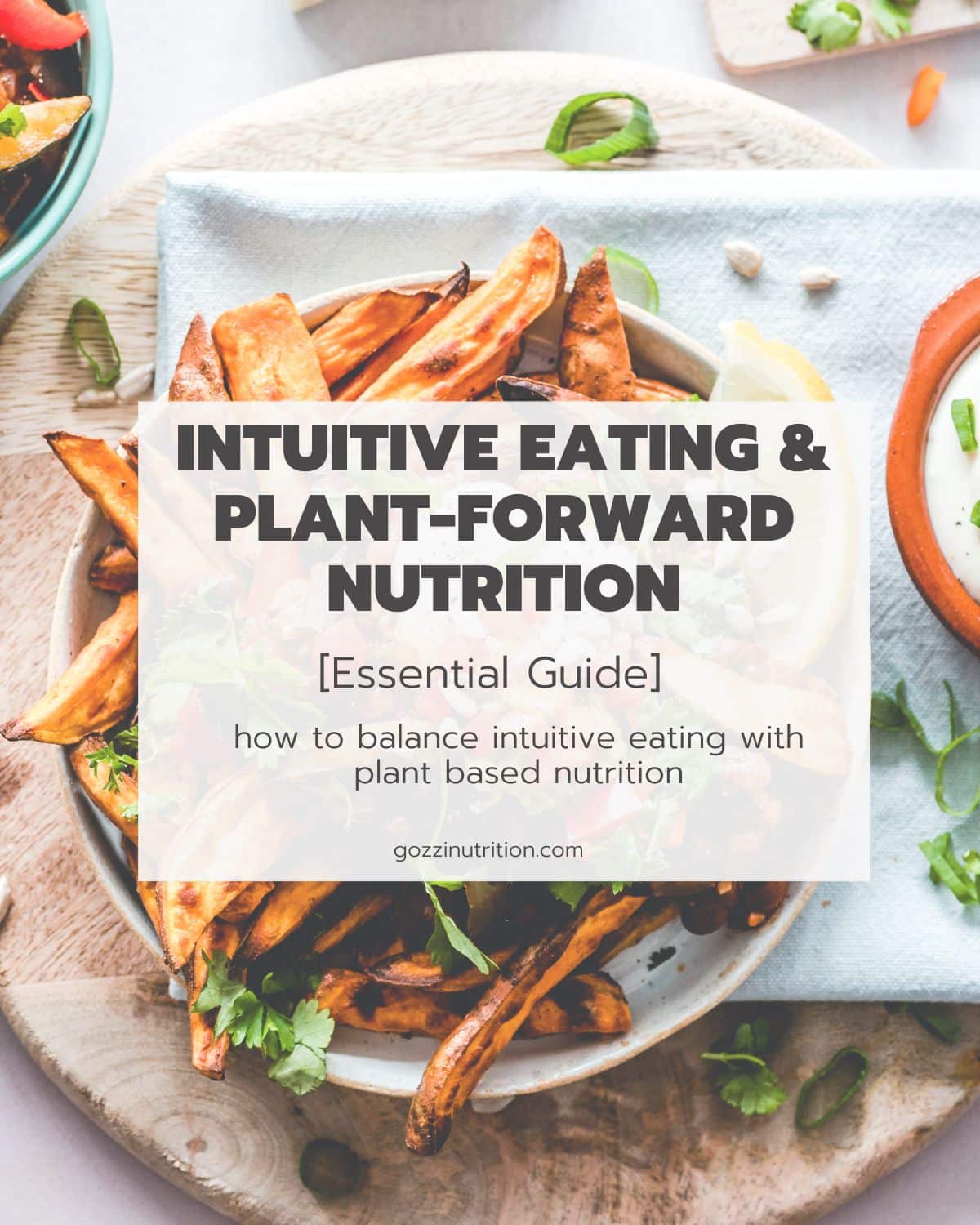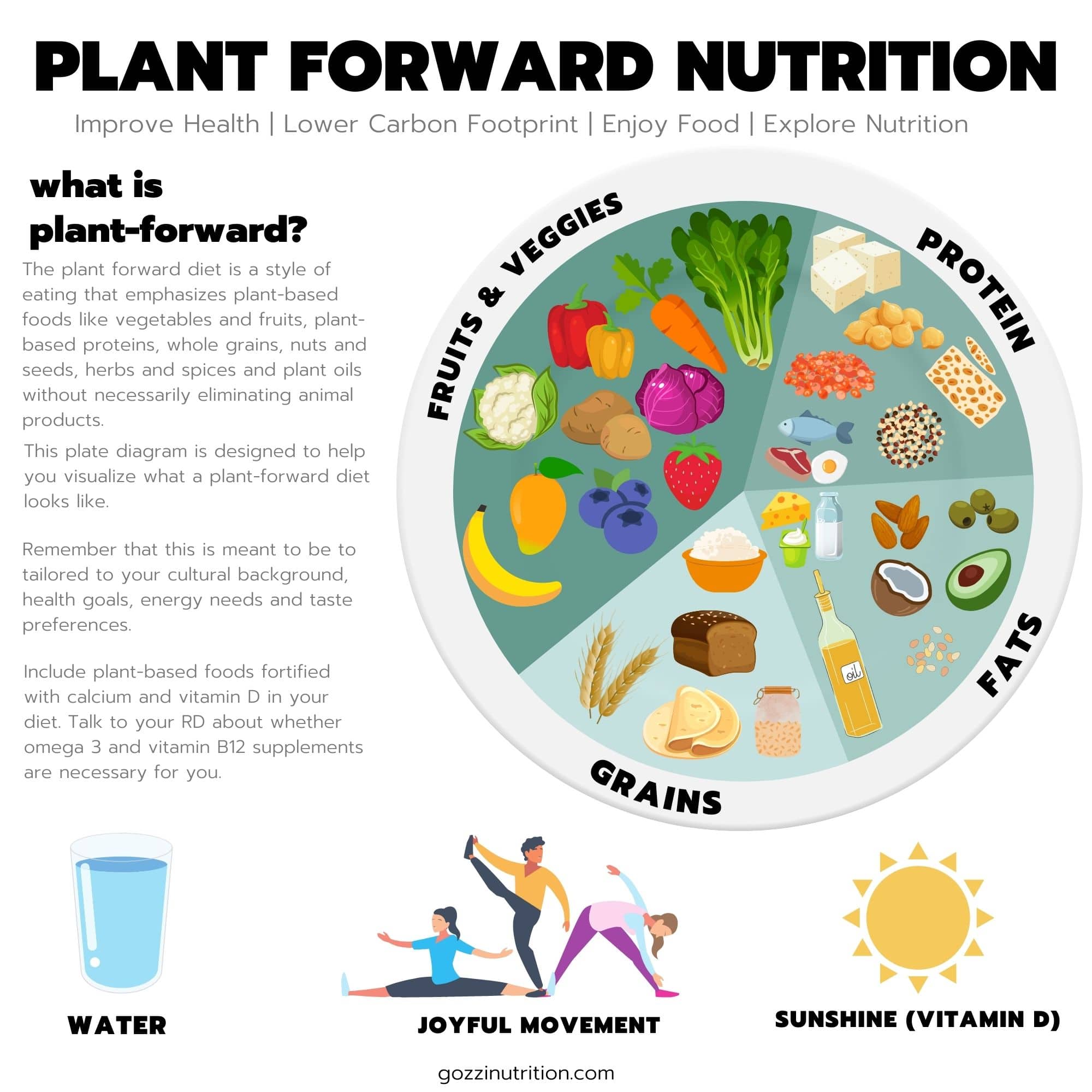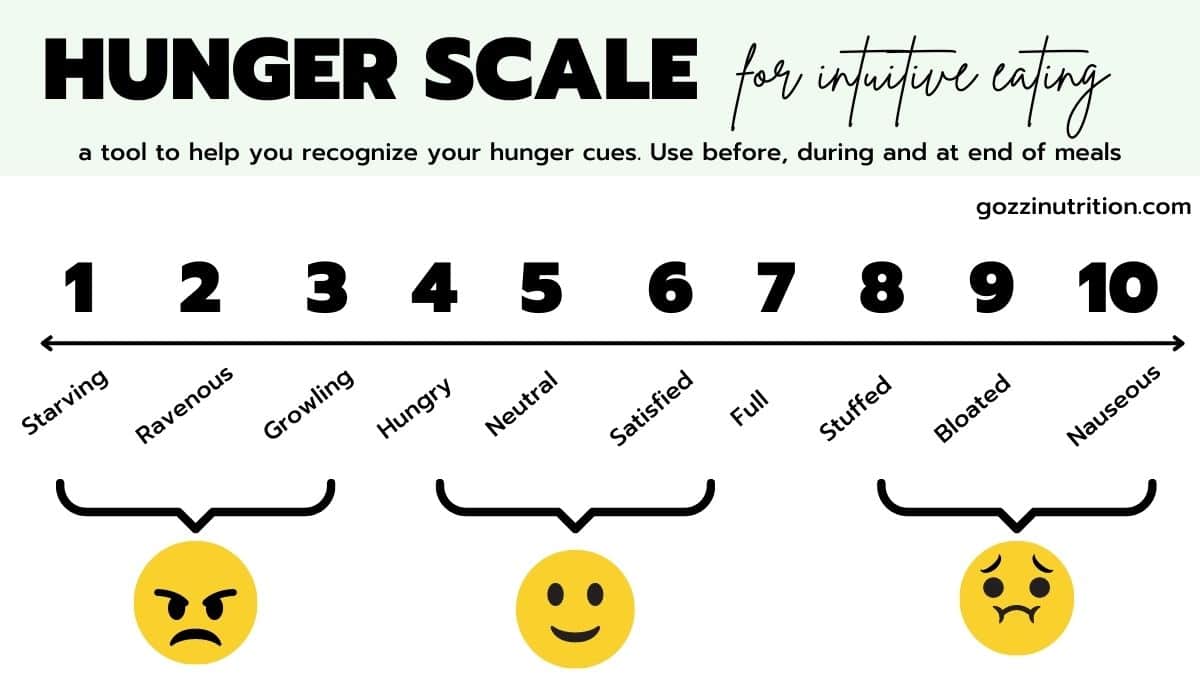Are you curious about the 10 principles of intuitive eating? Are you wondering how plant-based foods can fit into a non-diet approach to nutrition?
You’re in the right place!
I’m here to help you better understand how plant based eating and intuitive eating can coexist regardless of where you are on the spectrum of incorporating animal products into your diet.

Disclaimer: the content from this post and any part of this website (gozzinutrition.com) is not medical nutrition therapy. It is for educational and informational purposes only. It is not a substitute or replacement for medical care. If you are seeking individualized nutrition care, contact a dietitian or physician in your area.
This article is an exploration of how intuitive eating can benefit you in your relationship with a plant forward diet. For an in-depth exploration of intuitive eating, I highly recommend reading Intuitive Eating: A Revolutionary Anti Diet Approach by Evelyn Tribole MS RDN and Elyse Resch MS RDN.
Table of Contents
What is intuitive eating (and what it is not)
Intuitive eating is a non-diet approach to food, nutrition and overall well-being that was developed by two registered dietitians in the mid-1990s.
Intuitive eating helps you tune into your internal cues for hunger and personal health, rather than focusing on external messaging from the diet industry. This approach is designed to help you make peace with food and respect your body.
Intuitive eating is not a diet. It is not a weight loss plan. It is not about counting calories, or eliminating food groups. While there is an element of re-learning to enjoy all foods regardless of nutritional “value”, intuitive eating is not anti-nutrition or anti-healthy eating.
It is simply about nourishing your body on your own terms rather than the terms of the diet industry (collectively known as “diet culture” –more on that later).
A bit about my intuitive eating journey as an intuitive eating dietitian
I learned about intuitive eating when I was studying to become a registered dietitian. Like many dietitians before me, I became interested in nutrition because I wanted to lose weight.
Instead, I learned that nutrition and wellness are about so much more than weight and weight loss. The role of weight in health is a lot more complicated than the diet industry makes it seem.
I became a vegetarian because I was concerned about animal welfare. Over time, I found that approach too restrictive and my eating style evolved into plant forward nutrition. I share my journey in this episode of my podcast More Plants Made Easy.
Plant forward nutrition is an intuitive eating approach to plant based nutrition and how I help my clients find joy and simplicity in eating more plants.

Why are plant based diets controversial in intuitive eating communities?
Intuitive eating is a non-diet, inclusive approach to nutrition. Plant based and plant forward diets are centered around the elimination or reduction of animal products.
Unfortunately, diet culture, weight stigma, fatphobia and disordered eating is rampant within plant based diet communities, and that has turned away many people who might otherwise enjoy a more plant based diet. It almost turned me, a registered dietitian, away!
Many of my clients are simply trying to eat more fruits and vegetables and the next thing they know they are bombarded with messages to avoid this and buy this expensive miracle concoction.
As an intuitive eating dietitian that also works in the plant based space, I firmly believe that the two approaches can work together to optimize your relationship with food and your body image. Eating more plants, even being vegan, does not mean you must follow restrictive food dogmas.
A word about the word “diet”
I use the word diet simply to indicate a dietary pattern or style of eating. It is not meant to indicate weight loss or calorie restriction.
10 principles of intuitive eating and plant based and plant forward diets
If you are completely new to intuitive eating, read this post which summarizes the 10 principles of intuitive eating. I’ve listed them below in their original form:
- Reject the diet mentality
- Honor your hunger
- Make peace with food
- Challenge the food police
- Discover the satisfaction factor
- Feel your fullness
- Cope with your emotions with kindness
- Respect your body
- Movement–Feel the Difference
- Honor your health–Gentle Nutrition
Intuitive Eating Principle 1: Reject the plant-based diet culture mentality

Your task is to focus on non-weight and non-health related reasons to “follow” a plant-forward diet. This post from a vegan registered dietitian is an excellent overview of how using veganism as a weight loss diet detracts from core values of plant based nutrition.
Our food choices do not make us morally superior to anyone but it is helpful to understand how plant based foods can play a role in your value system. Here are some of my favorite examples:
- You care about the health of the planet and want to do everything you can to lower your carbon footprint.
- You are compassionate about the welfare of non-human animals and simply do not feel right eating them.
- You want to support the people that grow, process, clean and package our food.
- You love to cook, try new foods and explore cultures through a wide variety of tasty foods.
Intuitive Eating Principle 2: Honor your hunger as you transition to a plant based diet

Diet culture has taught us that it is bad to be hungry. It teaches us that when we are hungry we should drink water, go for a walk, or simply do ANYTHING other than eat a satisfying meal or snack.
Ignoring your hunger cues can actually lead to overeating. Overeating is a normal response and is nothing to be ashamed of, but it may not make you feel great!
Building balanced meals–a combination of fat, fiber, and protein– can help satisfy your physical hunger when you are transitioning to a more plant based diet.
There are many examples of how to do this but one of my client’s favorites is my formula for topped toasts.
PEANUT BUTTER-BANANA TOAST
- Fat + Protein: one tablespoon peanut butter
- Whole Grain: one frozen whole grain waffle or slice of whole grain bread, toasted.
- Fruit: one half banana, sliced
- Toppers: drizzle of maple syrup and cinnamon
AVOCADO-CUCUMBER TOAST
- Fat: quarter avocado, smashed
- Protein: one hard-boiled egg, chopped
- Whole Grain: one frozen whole grain waffle or slice of whole grain bread, toasted
- Veggie: sliced cucumber
- Toppers: sprinkle of “Everything But the Bagel” seasoning
YOGURT-BERRY TOAST
- Fat+ Protein: quarter cup 2% Greek yogurt or cottage cheese
- Whole Grain: one frozen whole grain waffle or slice of whole grain bread, toasted
- Fruit: mixed berries, fresh or thawed frozen
- Toppers: drizzle of sweetener of choice (and 1 teaspoon of chopped nuts and/or seeds)
HUMMUS-TOMATO TOAST
- Fat + protein: 1/4 cup hummus
- Whole grain one frozen whole grain waffle or slice of whole grain bread, toasted.
- Veggie: sliced tomato and lettuce
- Toppers: Drizzled with balsamic vinegar and sprinkle of salt and pepper
Notes: Measurements are approximate. Double the recipe for two pieces of toast.
Want more ideas? Listen to this episode of the More Plants Made Easy podcast.
Intuitive Eating Principle 3: Make peace with food.

This is one of my favorite of the 10 principles of intuitive eating: “Call a truce. Stop the food fight. Give yourself unconditional permission to eat.”
This applies to both plant based and non-plant-based foods. When we restrict a certain food, it only drives up our cravings for that food.
I used to restrict Cheez-its. I would never allow them in the house even though I would really crave them. When I did have them in the house, usually because my husband bought them, I ate so much that I felt sick.
Finally, I stopped depriving myself of Cheez-its. I bought them at the grocery store if I wanted them and allowed myself to eat them when I wanted. Eventually, the cravings went away and I could take them or leave them.
I’m an intuitive eating dietitian and I know this is scary. But it is a necessary part of your intuitive eating journey.
I want you to make a list of all the foods that you crave but don’t let yourself eat. And, under the supervision of a registered dietitian (like me) or certified intuitive eating counselor, give yourself permission to eat these foods, one at a time.
Intuitive Eating Principle 4: Challenge the plant-based food police.

The food police is a term that collectively represents all the messaging consumers receive about what is “good” to eat and what is “bad” to eat.
Many times, these messages are delivered by people that either a) have something to sell you or b) don’t know what they are talking about. Yes, I know that even doctors share messages about foods–but doctors receive very little nutrition training.
We internalize these messages and our own internal food police develops. We pass these messages onto our children and the cycle continues.
Processed foods are heavily demonized in the plant foods community. Ironically, processed foods are no-no amongst wellness influencers who sell heavily processed supplements and powders.
I’m a registered dietitian and I would never discourage you from eating “whole foods”, but the reality is that food processing is not inherently bad. In fact, processing like fortification and supplementation help vegans meet all their nutritional needs.
I could go on and on about this topic and all the elitist messaging around food, but I’ll leave you with a couple things to think about.
It’s ok to use frozen vegetables instead of fresh, try the newest “vegan junk food” or eat that cookie made with white sugar.
All foods can fit into a healthy diet.
Intuitive Eating Principle 5: Discover the satisfaction factor

If you are transitioning to a more plant based diet, you may be trying a lot of new foods. That’s great! You will like some of these foods more than others. There is no need to eat foods you don’t like.
Food provides us with so much more than just energy and physical satisfaction. I call this the “3 F’s of Food Satisfaction”
- Fullness (physical satisfaction that comes from eating balanced meals).
- Family and friends (food connects us to our heritage and other people)
- Flavor (sensory aspects of food like aroma, flavor, color, and texture)
In the Plant Forward Playbook Program, we use a food and mood journal so my clients can track the foods they are eating and reflect on how they enjoy them. Listen to Episode 008 of the More Plants Made Easy podcast where I do a deep dive into the “satisfaction factor” and food and mood journals.
Intuitive Eating Principle 6: Feel your fullness with a hunger scale for intuitive eating

It is important to not only understand when you are hungry, but also understand when you are full. Diet culture has made us rely on external cues like calories or arbitrary portion sizes to determine how full we are, rather than on our own internal feelings.
The most effective way to relearn your own hunger-fullness cues is to use a scale to measure them objectively. You don’t have to do this forever, and it is best to do it with the help of a registered dietitian. Eventually, you can learn to satisfy your hunger on your own terms.
There are a lot of different hunger scales for intuitive eating out there, mostly illustrating the same intuitive eating principle. Above is the scale I use with my clients.
When you are eating a meal, ask yourself the following questions.
- How full were you at the start of the meal?
- How full were you in the middle of the meal?
- How full were you at the end of the meal?
Intuitive Eating Principle 7: Cope with your emotions with kindness

Emotional eating is a natural response to stress and crisis. Despite what diet culture tells us, it is ok to eat to soothe our emotions on occasion.
In many cultures food is a typical component of the mourning process. The expression “food is love” exists for a reason.
Of course food won’t solve your problems unless the problem is hunger. If you find yourself eating to cope with your emotions on a regular basis or in a way that makes you feel worse, it may be helpful to speak with your registered dietitian or therapist about this.
Principle 7 of the 10 principles of intuitive eating is all about treating yourself with kindness and grace. You can also cope with your emotions through kindness to others. Consider contributing to your local food system to show your kindness. Here are some examples:
- Volunteer at a local food shelter
- Buy a bag of groceries for someone in need
- Reach out to a local registered dietitian or community service organization to see how you can help them promote healthy eating in your neighborhood
- Join a CSA program and support a local farmer
Intuitive Eating Principle 8: Respect your body (and other people’s bodies)

This is a really big topic that goes far beyond plant-based eating.
Body respect does not mean that you don’t ever want your body to change. It’s about accepting it when it does change. It’s also about minding your own business when it comes to other people’s bodies.
This is a tough one. I find that body respect becomes easier as you work through the preceding principles.
It can be helpful to learn about more nutrition and the non-weight management ways in which plant based foods support your overall health.
I do a deep dive into the health benefits of plant forward nutrition that are unrelated to weight management in my Essential Guide to the Plant Forward Diet.
Intuitive Eating Principle 9: Joyful Movement–Feel the Difference

Diet culture shapes how we think about exercise. There is absolutely nothing wrong with working out hard or pushing yourself. But exercising for the sole purpose of losing weight can be problematic.
Joyful movement is a great adjunct to plant forward nutrition. It means exercising for a wide range of benefits:
- Mental health
- Fun
- Increased energy
- Alone time
- Connection with nature
- Building strong muscles
- Increasing mobility and flexibility
- Meeting new people
- Bonding with loved ones
- Enjoying friendly competition
Find exercise you love and people you enjoy working out with (unless exercise is your “me time”). My favorite ways to move my body are playing tennis and taking nature walks and hikes.
Intuitive Eating Principle 10: Honor your health–Gentle Nutrition

It is ok to care about nutrition and to eat foods that nourish your body. This is especially true if you are using nutrition as a tool to manage a physical or medical condition.
The key is to incorporate health-supporting foods in your diet in ways that are personalized to your goals–not some external thing that diet culture warns us about.
It’s also important for plant based eaters, especially vegans, to ensure they are meeting all their nutrient needs.
Protein, vitamin B12, vitamin D, calcium, iron and omega-3 fatty acids are nutrients that plant -based eaters should learn about and pay special attention to.
Tune into Episode 006 of More Plants Made Easy for a deep dive into key nutrients on a plant based diet.
10 Principles of Intuitive Eating: Final thoughts
Intuitive eating is a non-diet approach to food, nutrition and overall well-being that was developed by two registered dietitians in the mid-1990s.
Intuitive eating helps you tune into your internal cues for hunger and personal health, rather than focusing on external messaging from the diet industry. This approach is designed to help you make peace with food and respect your body.
As an intuitive eating dietitian that also works in the plant based space, I firmly believe that the two approaches can work together to optimize your relationship with food and your body image. Eating more plants, even being vegan, does not mean you must follow restrictive food dogmas.
If you would like to learn more about how either/or intuitive eating and plant based nutrition could benefit you, book a free consultation with me today. Remember to grab your free copy of my plant forward meal prep guide.